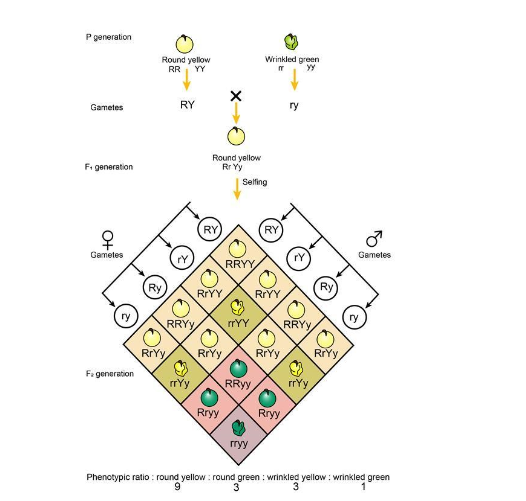Table of Contents
Introduction to Dihybrid
The study of genetics has revealed a myriad of inheritance patterns that determine the traits and characteristics of living organisms. Among these patterns, the dihybrid cross stands out as a fascinating exploration into the inheritance of two different traits simultaneously.
What is a Dihybrid Cross?
A dihybrid cross is a genetic experiment that involves the simultaneous inheritance of two distinct traits, each controlled by different pairs of alleles. The term “dihybrid” signifies the combination of two hybrid traits, where each parent carries two different alleles for each trait being studied. Through dihybrid crosses, geneticists aim to understand how alleles for different traits segregate and recombine during reproduction.
Punnett Square Illustrating Dihybrid Cross
Consider a dihybrid cross involving pea plant with two traits: seed color and seed shape. Let’s use capital letters (R and r) to represent the alleles for seed color (round and wrinkled), and capital letters (Y and y) for seed shape (yellow and green). The Punnett square for such a cross is a 4×4 grid that displays the possible combinations of alleles in the offspring.

In this Punnett square, each cell represents a potential genotype of the offspring resulting from the dihybrid cross. The combination of alleles from both parents determines the genetic makeup of the offspring.
Frequently Asked Questions (FAQs) on Dihybrid Crosses
What is the purpose of a dihybrid cross?
A dihybrid cross allows geneticists to study the inheritance patterns of two different traits simultaneously and observe how the alleles for these traits segregate and assort independently.
What is the principle of independent assortment in dihybrid crosses?
The principle of independent assortment states that alleles for different traits segregate independently of one another during gamete formation. This means that the alleles for seed colour do not influence the segregation of alleles for seed shape, and vice versa.
What is the genotypic and phenotypic ratio of a dihybrid cross?
The genotypic ratio of a dihybrid cross is 1:2:1: 2:4:2: 1:2:1 and the phenotypic ratio is 9:3:3:4.
What is a test cross, and how is it used in dihybrid crosses?
A test cross involves breeding an individual with a dominant phenotype but unknown genotype with an individual with a homozygous recessive genotype. In dihybrid crosses, a test cross can help determine whether the individual with the dominant phenotype is homozygous or heterozygous for both traits.
What is the significance of Mendel's law of segregation and law of independent assortment in dihybrid crosses?
Mendel's law of segregation states that alleles segregate during gamete formation, and the law of independent assortment states that alleles for different traits assort independently. Both principles are critical in understanding dihybrid crosses, as they explain how genetic diversity is maintained and inherited.






